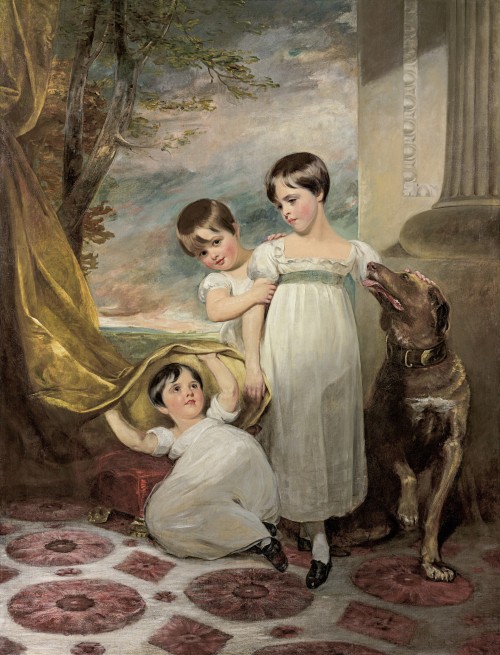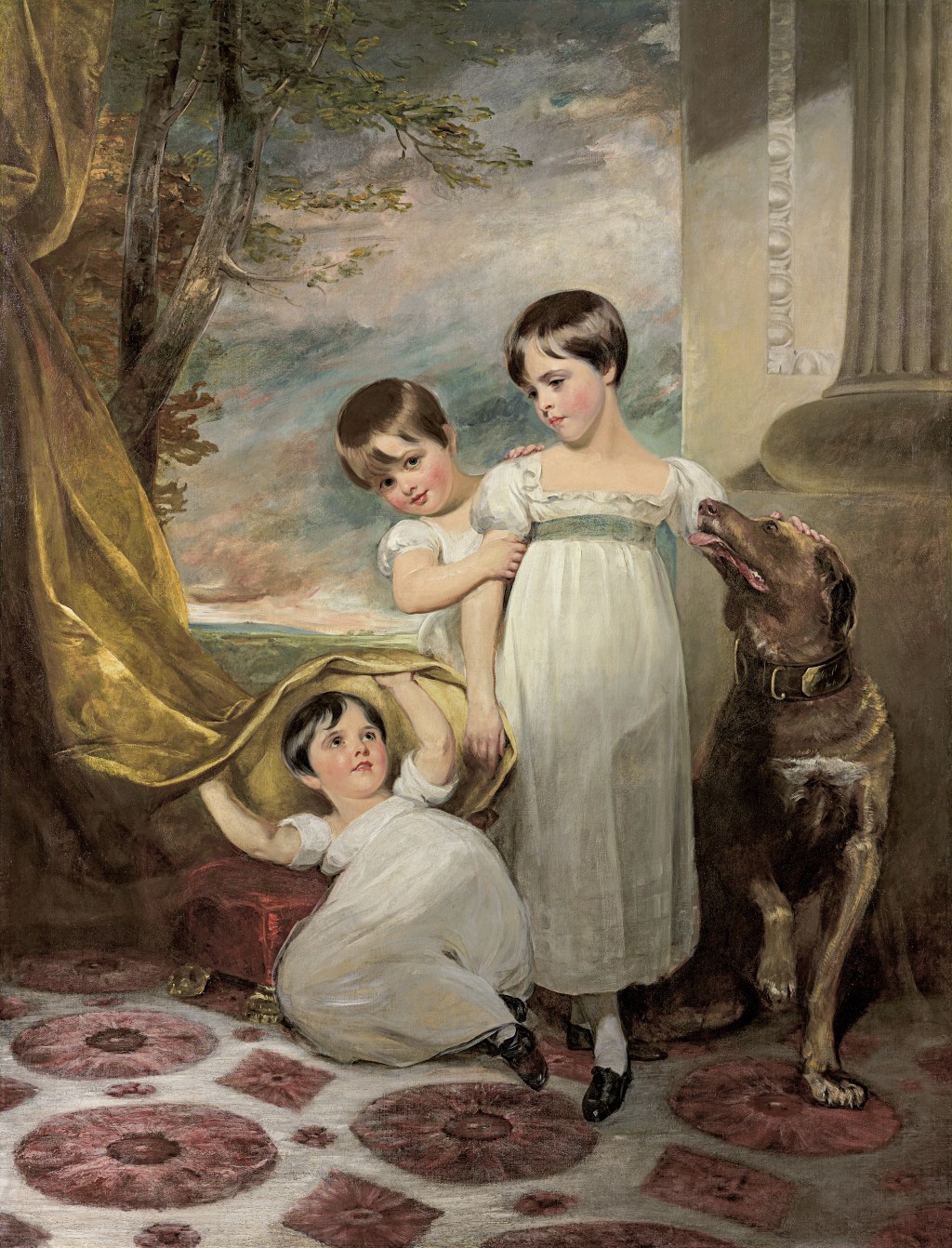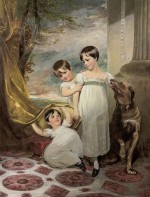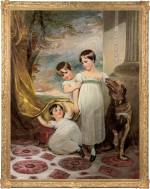GEORGE HENRY HARLOW
1787 – London - 1819
Ref: CC 143
Portrait of Catherine (1811-1877), Selina (1812 - 1883) and Louisa Jenkinson (1814 - 1887), daughters of Charles Cecil Cope Jenkinson, later 3rd Earl of Liverpool
Oil on canvas: 75 5/8 x 57 7/8 in / 192.1 x 147 cm
Frame size: 83 5/8 x 66 in / 212.4 x 167.6 cm
Painted circa 1817
Provenance:
Charles Cecil Cope Jenkinson, 3rd Earl of Liverpool (1784-1851), Buxted Park, East Sussex;
The Hon. Henry Berkeley Portman, 3rd Viscount Portman (1860-1923);
Emma, Viscountess Portman (1862-1929), by 1926;
her daughter Lady Moyra Dawson-Damer (1897-1962);
by descent
Literature:
Lord Hawkesbury, Catalogues of Portraits at Compton Place and at Buxted Park, in Sussex, 1903, p.18, no.2 (as at Buxted Park, East Sussex, hanging in the Dining Room, East Wall)
This charming painting of the three daughters of the widowed Charles Cope Jenkinson is by George Henry Harlow, the talented pupil of Sir Thomas Lawrence (1769-1830). It combines the grandeur of aristocratic group portraits of children, seen in the work of Sir Anthony van Dyck (1599-1641) and Sir Joshua Reynolds (1723-1792), with a newly Romantic appreciation of the personalities and psychology of the young. The eldest, motherless girl, Catherine, looks down gravely at her ebullient youngest sister Louisa, who is intent on tangling herself in a curtain of golden satin. Selina, the middle child, shyly peeps out from behind her sibling’s skirts, entwined both physically and by family affection. The children are accompanied by a huge, friendly mastiff. They stand on a lavish carpet of English manufacture, against a fictive window with rolling countryside and a stormy sky, its energy reflecting the freshness of their youth.
Charles Cope Jenkinson was the younger son of the statesman Charles Jenkinson, 1st Earl of Liverpool (1729-1808) and half-brother of Robert Banks Jenkinson, 2nd Earl (1770-1828), one of Britain’s longest-serving Prime Ministers. Robert Jenkinson was in office from 1812 to 1827, during the final, crucial years of the Napoleonic Wars and the Congress of Vienna. Charles Jenkinson served as an MP for Sandwich, Bridgnorth and East Grinstead and as Under-Secretary of State for War and the Colonies 1809-10, but was not included in his brother’s administration. Charles inherited the Earldom from his childless brother in 1828 and was appointed Lord Steward of the Household of the young Queen Victoria in 1841, a post he held until 1846.
In 1810 Charles Jenkinson married Julia Evelyn, daughter of Sir George Augustus Shuckburgh Medley Evelyn and Julia Evelyn. As sole heir, the younger Julia inherited the Felbridge and Medley estates in Sussex, which included Buxted Park, to add to the Jenkinson inheritance of Pitchford Hall, Shropshire. Sadly, Jenkinson’s wife died in 1814, leaving his three little girls as heiresses. The Earldom of Liverpool became extinct on Jenkinson’s death in 1851, but in 1905 was revived for his grandson, the Liberal politician Cecil Foljambe (1846-1907).
As might be expected, all three of the children in this portrait married into prominent aristocratic families. Catherine (Lady Catherine from 1828[1]) married Col. Francis Venables-Vernon-Harcourt, son of the Most Rev. Edward Venables-Vernon-Harcourt, Archbishop of York, and his wife Lady Anne Leveson-Gower, daughter of the 1st Marquess of Stafford. The marriage produced no children. In 1833 Lady Selina married William Wentworth-Fitzwilliam, Viscount Milton (1812-1835). Her only child, the Hon. Mary Selina Fitzwilliam, married the 2nd Viscount Portman and it is in the Portman branch of the family that Harlow’s painting has descended.
In 1845 Lady Selina made a second marriage, to George Foljambe. Lady Louisa Jenkinson married John Cotes, the son of John Cotes and Lady Maria Grey, daughter of the 5th Earl of Stamford.
Susan Morris
GEORGE HENRY HARLOW
1787 – London – 1819
George Henry Harlow was born in London, the posthumous child of a China merchant. After Westminster School, he was apprenticed to the landscape painter Henry de Court and the portrait painter Samuel Drummond, ARA. Around 1802 Harlow joined the studio of Thomas Lawrence as a pupil and studio assistant. Lawrence had an indelible effect on Harlow’s own style, but the relationship soon struck the rocks: Harlow comprehensively demolished it by painting an inn sign for the Queen’s Head, Epsom (where he had run up a bill), caricaturing Lawrence’s manner and signing it T.L., Greek Street, Soho. According to contemporary reports, Harlow was a spoiled, vain fop, leading to acquaintances nicknaming him ‘Clarissa Harlowe’, after Richardson’s heroine. He was, however, a richly talented rake.
Harlow exhibited at the Royal Academy from 1804, firstly history paintings and then portraits. He was a brilliant draughtsman with a luscious, sensuous handling of paint and an ability to catch physical likeness and personality. His portraits included Benjamin West, President of the Royal Academy (RA 1815) and Sir William Beechey (RA 1816). Harlow’s portraits of fellow artists were often done gratis, to curry favour, but he was unsuccessful in becoming an ARA in 1816. Harlow drew Lord Byron and painted several portraits of famous actors in character, including Sarah Siddons as Lady Macbeth, c.1814. According to Richard Redgrave, Harlow embraced the bohemian life of the thespians with which he associated, ‘and being of an easy, careless disposition, soon became embarrassed in his affairs’. His Court scene from the Trial of Queen Katherine from Shakespeare’s Henry VIII, painted for the singer Thomas Welsh, caused a sensation at the Royal Academy in 1817 and influenced stagings of the play well into the nineteenth century.
In 1818 Harlow travelled to Italy. He made drawings of Lord Byron and his mistress Margarita Cogni at the Palazzo Mocenigo in Venice (both in the John Murray Collection), suggesting a closer relationship with the poet than the conventions of a formal portrait sitting. Through Byron, Countess Benzoni provided a letter of introduction to Antonio Canova in Rome. In eighteen days, Harlow made a copy of Raphael’s monumental Transfiguration (1517-20), hoping to exhibit it in England. His Wolsey receiving the Cardinal’s Hat in Westminster Abbey was exhibited at Canova’s house and given to the Academia di San Luca, which elected him a member, a rare honour for an Englishman. Harlow was invited to submit self-portraits to the Academia and the Uffizi in Florence. He visited Naples and Pompeii, was presented to Pope Pius VII and was elected a member of the art academy in Florence on his way back to England.
Harlow landed in Dover on 13th January 1819, seemingly with a bright future ahead of him. Sadly, a sore throat contracted on the journey turned into a fatal infection. He died at his lodgings at 83 Dean Street, Soho and was buried in St James’s Piccadilly through the generosity of the frame maker Tijou, without which, Joseph Farington recorded, ‘He must have been buried at the expense of the Parish’. Writing to Farington from Vienna, where he was painting the victors of the Napoleonic Wars, Lawrence confessed that, despite his pupil’s foibles, ‘No one I believe appreciated [Harlow’s] genius more highly than myself…So rare is the appearance of great power in Art, one must wonder…that it is given to the World so suddenly to be withdrawn’[2].
The work of George Henry Harlow is represented in the Royal Academy, London; the National Portrait Gallery, London; Eton College; the Ashmolean Museum, Oxford; the Academia di San Luca, Rome; the Uffizi, Florence and the Metropolitan Museum of Art, New York.
[1] Lady being courtesy title of the three girls after their father inherited the Earldom.
[2] Oxford Dictionary of National Biography, Annette Peach, ‘Harlow, George Henry (1787-1819)’, 2004.











